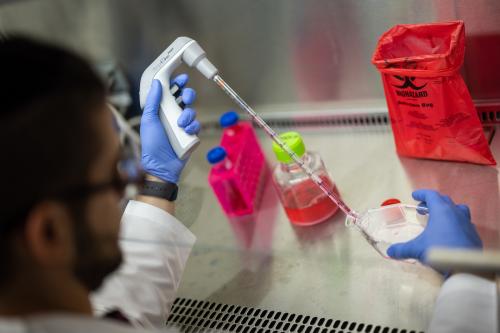
Hazardous Waste Program
OEHS has a comprehensive management program to address the use, handling, storage, and disposal of hazardous materials. These materials include chemical, biological, radiological, and other hazardous substances. Specific handling and storage criteria for laboratories is addressed in the Chemical Hygiene Plan. Waste disposal is a major component of hazardous materials management.
Hazardous Waste Management
Hazardous waste is waste with properties that make it dangerous or capable of having a harmful effect on human health or the environment. Hazardous waste is generated from many sources, ranging from industrial manufacturing process wastes to batteries and may come in many forms, including liquids, solids, gases, and sludges. The Resource Conservation and Recovery Act (RCRA) outlines specific regulatory requirements for hazardous waste and universal waste. Universal waste includes some batteries, pesticides, used-oil, mercury-containing equipment, lamps, electronic equipment, and antifreeze.
Universal waste is managed by Campus Services with the exception of mercury-containing equipment which is managed by OEHS and e-waste which is managed by Materials Management.
Hazardous waste is either listed or characterized by the EPA into one of four properties: ignitability, corrosivity, reactivity and toxicity. The EPA stipulates how wastes are to be managed for disposal. Requirements are based on the Generator Status of the facility, which is determined by the volume and types of waste being produced. Stricter rules are enforced for facilities with a larger Generator Status.
At Tulane, OEHS manages Central Accumulation Areas (CAAs) on each campus where Hazardous Waste is stored prior to disposal by a contracted Hazardous Waste Vendor. In addition, the EPA allows for temporary storage of Hazardous Wastes in Satellite Accumulation Areas (SAAs) prior to storage in the CAAs. These are storage locations at the site of waste generation, generally in lab or shop rooms. The Supervisor, Lab Manager, or Primary Investigator for a room containing a SAA is responsible for its management and must familiarize themselves with these rules.
Waste managed by OEHS includes:
Hazardous and Universal Waste
EPA Generator Status
EPA has specific requirements for the CAAs depending on the volume of waste that is generated on site and requires for facilities to evaluate their waste streams to verify the amount of waste that is generated. Tulane maintains several generator statuses by location.
- The Tulane Uptown and Downtown Campuses are classified as Large Quantity Generator sites.
- TNPRC and Hebert are classified as Small Quantity Generator sites.
- The School of Public Health, Environmental Medicine, and the New Orleans Bioinnovation Center (NOBIC) are classified as Very Small Quantity Generator sites.
Policies
Information about Tulane's requirements for the handling and proper disposal of hazardous waste is addressed in the Hazardous Waste Management Policy. Universal waste is addressed in the Universal Waste Management Policy. These Policies are available to read on the Policies & Procedures page.
Training Requirements
Training is required annually for individuals generating hazardous waste or universal waste on Tulane's Campuses. There are two available training courses for waste generators:
Hazardous Waste Management - Intended for OEHS and Facilities employees who will be managing CAAs or Universal Waste storage areas. Details how to determine generator status of a facility, CAA management, and Universal Waste Rules.
Hazardous Waste Training - Intended for anyone working in a space where Hazardous Waste is generated (labs, shops, etc). Details how to manage your waste areas and store waste correctly. The contents of this course are included in the OEHS Safety Training for Researchers combined training presentation (see the Lab Safety page for more info).
These trainings are available to employees through TU Learn. Students can access these trainings through Canvas. For more information about access to online training modules, please visit the Training page.
Process for Hazardous Waste Disposal Services
- Ensure the relevant Hazardous Waste training course has been completed within the last year.
- Submit a hazardous waste pickup request via SciShield or email OEHS@tulane.edu if you are not assigned to a SciShield group.
- Log in to SciShield and follow the start-up wizard if your group is not registered.
- Open your lab's group tab and select the "Waste" option
- Click on "Submit New Chemical Waste Pickup Request."
- Select "Hazardous Waste" from the Material Type pull-down.
- Indicate the total number of containers, their amounts including units, and their location(s).
- Fill out optional fields if desired: Constituents, Hazards, Supplies Needed, and Additional Details.
- Note: For pickups containing multiple different chemical containers, you may summarize the materials in the Additional Details field, rather than submitting multiple pickup requests. You are not required to enter a separate pickup request for every container.
- Press Submit.
3. The Hazardous Waste Team will contact you to schedule a pick-up within a week of submitting the request.
For questions related to hazardous waste, email OEHS@tulane.edu.
Waste Labels
Labeling Hazardous Waste Fact Sheet
Satellite Accumulation Areas (SAAs)
Spills
Spill Response and Clean-Up Flow Chart
Other Wastes
Sharps and Broken Glass Disposal Fact Sheet
